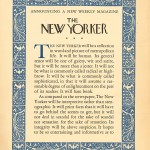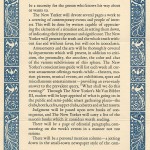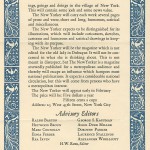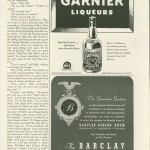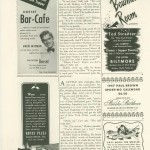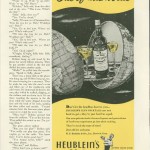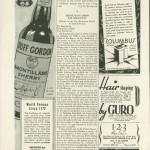By Daniel Maseda

Nestled between advertisements for the chic Canadian Château Frontenac, the 1947 Paul Brown Sporting Calendar from Brooks Brothers, two separate waterfront Miami vacation destinations, and distinguished liquors and wines, J. D. Salinger’s short story “Slight Rebellion Off Madison” appeared in the December 21, 1946 issue of The New Yorker. [1] Portraying the anxious attempts of a teenage preparatory school student to escape with his sweetheart from the restricting world of the New York City to the open land of the north, this piece was the first in a long line of Salinger’s short works to be published in the revered and widely circulated magazine. Salinger would go on to publish stories in The New Yorker with increasing frequency in the years that followed, as acclaim and approval for his work grew rapidly among audiences and editors alike. By the end of the decade, his work would become a staple of the magazine, to the extent that Salinger and The New Yorker were indicative of each other even in name. Though he had published sixteen stories in other magazines before the publication of “Slight Rebellion,” it was his relationship with The New Yorker that ultimately catalyzed his emergence in the literary mainstream and positioned him at the forefront of contemporary American fiction in the midcentury post-war era. Just as critics specifically recognized Salinger as “a New Yorker writer,” The New Yorker was his platform.[2]
Yet, the development of the relationship between Salinger and The New Yorker and the writer’s rise to prominence more generally were not without difficulty. The first several stories that the writer submitted to The New Yorker were not well received by the magazine—in fact, they were not received at all. Rather, his path to publication in The New Yorker was a process drawn out over several years marked by numerous rejections and vocalized resistance from editors. However, many of the atypical or extreme qualities of Salinger’s writing that made his works sources of conflict when initially considered for publication are the same qualities that readers celebrate still today as distinguishing Salinger from his contemporaries and his writing from conventional forms of American fiction: his distinct cleverness, the perceptiveness of his narrative perspective, and the precision of his narrative voice, among others. His characteristic use of these stylistic marks to portray individuals who situate themselves outside of the conventions of their social environment and who identify as fringe relative to the mainstream presents a parallel for many modern readers’ and writers’ conceptions of J. D. Salinger. Critical, analytical, and biographical literature on the writer consistently acknowledges and engages the fringe qualities of his life and works, ranging from his tendency to portray misfits, to the public controversy surrounding the publication of his seminal novel The Catcher in the Rye in 1951, to his ultimate early retirement from publishing and reclusive lifestyle. The influence of these qualities on Salinger’s public status and persona renders him a fringe figure in a sensational sense; the very elements of his writing and lifestyle that situated him outside of contemporary literary conventions were the same that drew mass cultural attention to him.
Just as it does today, The New Yorker had a recognizably distinctive stylistic voice that corresponded to its specific cultural function in the mid-twentieth century. The sustaining of that voice and its success were due to especially deliberate editorial practices and efforts on the part of the magazine. It was only because editors had a sense of what defined the “perfect New Yorker writer” that critics could categorize Salinger as specifically “a New Yorker writer.”[3] Considering the prestige and prominence of The New Yorker as a cultural and literary outlet, it is certain that Salinger, in the process of submitting his stories to and ultimately being published in the magazine, subjected his work to the magazine’s rigid editorial guidelines and conventions. However, Salinger’s ability to emerge into the mainstream despite—or perhaps because of—those qualities of his writing that led to his early rejections suggests a degree of significant adjustment on the part of either the writer or the magazine, or, most likely, both. For a writer rejected multiple times by The New Yorker to become a distinctive “New Yorker writer” indicates tailoring on the part of the writer to the active conventions; the exceptional position of Salinger at his height as a distinctive and expected feature of The New Yorker indicates a relaxing of convention on the part of the magazine to better suit the writer. In his comprehensive history About Town: The New Yorker and the World It Made, Ben Yagoda writes that Salinger published stories set “in familiar New Yorker locations…but [that] something about Salinger’s treatment created a sensation.”[4]
This distinct treatment entails on the part of Salinger’s characters driven efforts toward a resistant self-situation in relation to the elite, the presentational, and the advertised, that in the very act of self-positioning in fact engages and reveals the characters’ keen interest in that which they resist. In the case of “Slight Rebellion Off Madison,” the distinct names and brands that seem to permeate the environment and social perspective of the teenager in question, a young Holden Morrisey Caulfield, provide him the opportunity to reductively label and categorize his general anxieties about his own social self-situating. The “treatment” of which Yagoda writes is evident here, as Salinger grounds his narrative in recognizably New Yorker-esque images and themes but presents them with an unanticipated slant.This essay takes up as its topic Salinger’s passage from fringe writer to literary and cultural “sensation” in the 1940s and early 1950s. In examining the development of Salinger’s short fiction from its beginnings in smaller-scale publishing outlets to its eventual prominence in The New Yorker from literary, critical, and theoretical perspectives, it aims to understand the degrees to which writer and magazine each brought about adjustments in the other within the social and cultural context of postwar midcentury America. A thorough studied awareness of the conventional patterns in his form—the short story—and medium—the magazine in form and The New Yorker in brand—allowed Salinger to invert standardized practices, using his adherence to the standard as a manner of creatively reframing it.
Contextualizing Salinger: The Schooling of Convention
Viewing Holden Caulfield’s self-identification and positioning as an outsider as a framework for the portrayal of a young, creative, and genuine mind resistant to the operative cultural institutions in his world, much of the biographical literature on Salinger looks to the complications of Salinger’s own schooling years to identify the origins of his fringe qualities. Growing up in New York City, Salinger spent many years in and out of Manhattan public grammar schools, until in 1932 he began a brief stint at the prestigious McBurney School—the school set to compete against the Pencey Prep fencing team when Holden Caulfield forgets the equipment on the subway at the beginning of The Catcher in the Rye.[5] Referring to Salinger’s time at McBurney, a peer noted that the writer “wanted to do unconventional things” and that “For hours, nobody in the family knew where he was or what he was doing; he just showed up for meals.”[6] Though engaged in extracurricular activities, Salinger was ultimately asked to leave McBurney due to poor academic performance. The direct connection of the school to The Catcher in the Rye certainly gives rise to potential readings of Holden Caulfield in young Salinger as a McBurney student, seeing Salinger’s rejection from the institution as a justification for Holden Caulfield’s friction with his own school and what it represents. Yet, Thomas Beller notes that such a reading is “natural” but somewhat “reductive.” Beller proposes that “Salinger’s primary association with McBurney…was humiliation,” but questions whether the school itself was the actual source of that humiliation, going on to argue that McBurney served more as a source for Salinger’s exposure to the isolation and vast potential of the urban landscape of New York City.[7]
In this sense, Salinger’s troubled early schooling years were marked by a degree of displacement—or perhaps misplacement—that presented an institutional framework in relation to which his position was off-center. Yet, by the end of his high school years, Salinger would see success as a student despite the pattern of transferring and rejection. One year after his departure from McBurney, he transferred once more to attend the Valley Forge Military Academy in Wayne, Pennsylvania, from which he would go on to graduate in 1936. Critics alternately describe Salinger as being “sent,”[8] “banished,”[9] and “escorted;”[10] Salinger’s time at the academy certainly exposed him to the potential frustrating restrictions imposed upon the young and developing creative mind. Classmates of Salinger’s at Valley Forge remembered him most distinctly for both his rule-breaking behaviors—one peer invoked theatrical language to describe Salinger as “miscast in the military role”—and his particular gift for writing.[11] The recognizable anxiety, doubt, and resentment toward the restraints posed by cultural institutions that mark Salinger’s writing even in his earliest published stories, then, might be read as a manifestation of the complications the writer experienced in his schooling years. Though there is no absolute indication that Salinger in his time at Valley Forge was himself an outsider or a fringe figure—in fact, the young writer was highly involved in numerous student organizations, even serving as the editor of the academy’s yearbook in his senior year—Salinger himself claimed that his “boyhood was very much the same as that of the boy in the book [Holden Caulfield in Catcher].”[12] In this sense, Salinger’s development throughout his schooling years makes evident a fundamental tension between the roles prescribed for the young writer and his manner of thriving within—or rather, around—the restrictions thereof.
The Early Stories
Whereas Salinger’s early education served to expose him to the possibility of thriving by way of unconventional methods, his continued higher education served to introduce him to the available techniques to harness that potential in writing. Salinger’s schooling eventually provided him with the motivation and resources necessary to propel himself into the literary world with his first published short story. Though accounts of Salinger’s activity in the years immediately following his graduation from Valley Forge are few and conflicting, it is clear that after reported brief stints at New York University and Ursinus College, the young writer enrolled in course on the short story taught by Whit Burnett, editor of Story magazine. After a nearly an entire year of inactivityon Salinger’s part, according to Burnett, the young writer fell into a generative mode in the final weeks of the course, ultimately submitting a story to Burnett that the teacher and editor would select for publication in Story.[13]
Titled “The Young Folks,” Salinger’s story portrays the circuitous attempts of college student William Jameson Junior to socialize his way inward from the periphery of an apartment party, organized by the hostess as an occasion to “drink her father’s scotch.” Upon striking up a conversation with a friend of the hostess on the apartment’s terrace away from the escalating buzz of the party, Jameson feels an increasing draw toward the swelling uproar and laughter of an interior conversation between a notable “small blonde” and a cluster of “three young men from Rutgers.”[14] Largely dialogic in narrative, the story engages themes of authenticity, gossip, and conventions of appearance in its quick and sweeping conversations. It exhibits signs of a particular anxiety toward and disdain for artifice that would later become indicative of Salinger’s writing, as well as an interest in conveying that disdain and anxiety through a narrative structure more through narrative perspective than through a rigidly defined plot. For a young writer such as Salinger, Story provided a “serious” venue for publication on a smaller scale than mass-circulated cultural magazines yet in a less rigid framework than would be provided by a more narrowly defined literary magazine.[15] Burnett’s magazine was known for “discovering new, young talent,” Salinger’s publication therein would serve to align him with contributors would go on to become some of the more prominent names in American literary circles.[16]
By the end of 1940, Salinger would go on to publish a second story, “Go See Eddie,” this time in the University of Kansas City Review. Like “The Young Folks” in Story, Salinger’s second published piece reached a readership relatively limited in scope by nature of its magazine compared to that of a more prominent channel such as The New Yorker. However, this exposure provided the twice-published twenty-one-year-old with the momentum to emerge into the literary mainstream the following year. 1941 saw Salinger’s first publication in a mass-circulated, well-paying “slick” magazine when Collier’s purchased and printed his short story “The Hang of It,” in which the father of a recent Army conscript reflects on a former platoon mate of his own for whom the fulfillment of their sergeant’s commands was effectively impossible.[17] The father, ultimately revealed to be a colonel, finds that his son in the present is equally as “out of step” as the platoon mate had been, and the story closes with a subordinate officer reporting to the father that the situation is hopeless.[18] Arthur Mizener, writing in Harper’s Magazine in 1959, criticizes this early writing as being concerned, “in a mechanical and overingenious way, with the superficial interests of magazine readers at the time.”[19] By contrast, Ian Hamilton writes that the story’s success and significance rested in its having “all the right Collier’s ingredients,” arguing that “He had written to length and to formula” but also “perceived that a genial, tough-but-tender cuteness of address came to him easily.”[20]
Later that year, Salinger, effectively legitimized as a writer with his appearance in Collier’s, would address the very “ingredients” and “formula” of the magazine that brought him his recent success and exposure with the publication of his story “The Heart of a Broken Story” in Esquire magazine. The piece, framed as the hypothetical writing of a separate short “boy-meets-girl” story for Collier’s from the perspective of a fictional writer, recognizes and deconstructs the narrative expectations of Collier’s as a metonym for magazines publishing fiction more generally. Frustrated with the inevitable structure toward which his own narrative begins to tend, the narrator appeals to the reader’s best sensibility in detecting the conventions at play: “Maybe you’re beginning to see what I was up against.”[21] What Salinger exhibits in this story is a heightened, studied awareness of the forms within which he operates as a contributor to literary outlets of varying contexts and agendas. Yet, in lampooning those forms, he does not simply position himself outside of them. Rather, by playfully setting himself against the operative forms of Collier’s, he in turn sets himself in line with the operative forms of Esquire. Hamilton notes the remarkability of the writer’s ability to “concoct the kind of material that Collier’s—and, come to that, Esquire—would go for,” adding that Salinger “was trying to get the best of both worlds, and he knew it.”[22] “The Heart of a Broken Story” makes evident a growing direct interplay between the young writer and his media. Though his satirical voice in this case lacks much of the subtlety present in his later work, Salinger employs a recognizable wit, narrative perceptiveness, and indirect self-defeat to reframe the ordinary and the accepted as peculiar. His manipulation of the prevalent standardized forms, while indicative of his unavoidable operation within those structures, serves to centralize his work within the literary sphere while simultaneously pushing it out toward the fringes.
Contextualizing The New Yorker: A Metropolitan Consciousness
In 1924, founding editor Harold Ross released a prospectus outlining his initial expectations for The New Yorker, addressing the range of content and the cultural functions he envisioned for the magazine. Ross opens the prospectus by defining the proposed scope of The New Yorker:
THE NEW YORKER will be a reflection in word and picture of metropolitan life. It will be human. Its general tenor will be one of gaiety, wit and satire, but it will be more than a jester. It will not be what is commonly called radical or highbrow. It will be what is commonly called sophisticated, in that it will assume a reasonable degree of enlightenment on the part of its readers. [23]
In his framing of the magazine’s effective mission statement, Ross classifies a specific and distinct New Yorker voice as the definitive quality of primary importance in creating the magazine, setting it as taking precedence over the practical organization of the content itself. Second in importance to the New Yorker voice is the socially, intellectually, and geographically distinct audience to which it caters, as Ross writes, “THE NEW YORKER will be the magazine which is not edited for the old lady in Dubuque. It will not be concerned in what she is thinking about…It expects a considerable national audience, but this will come from persons who have a metropolitan interest.”[24] In each case, Ross expresses a particular interest in defining the voice or audience of his magazine in negative relation to those of prominent magazines whose practices are “commonly” recognized. In this sense, at its inception, The New Yorker was fundamentally narrow in scope; Ross’ conceptualizing language indicates an intention to fill a present void in the magazine industry, which in turn indicates the establishment of and operation within a clearly defined and rigid framework.
By the time of Salinger’s first submissions to the magazine, the cultural landscape of The New Yorker had undergone significant shifts. Though the “general tenor” initially imagined by Ross endured as a primary indicative and definitive quality of the magazine, the initial ambitions of The New Yorker were formed out of and grounded in what Yagoda describes as “the 1920s ethos of ascendance, architectural, literary, and social.”[25] The New Yorker in its originally intended form served as a medium for what Daniel Tracy terms “middlebrow culture,” or “ a set of processes within mass culture directed toward a particular ‘common interest’: identifying and teaching high culture.”[26] As The New Yorker’s readership expanded in number and scope—the majority of the once entirely New York City-based audience lived outside of the city within five years of the magazine’s founding[27]—the sense of the “metropolitan interest” to which Ross referred evolved, in turn shifting the framework and approach of the magazine’s discourse even with Ross’ expectations for a “considerable national circulation.” The onset of the Great Depression and, more significantly, the subsequent transition into World War II further redefined the magazine’s “metropolitan” audience in terms of its interest in leisure, its cultural needs, and its social positioning. The magazine in this period took more direct interest in gauging the constituency of its readership and comparing that constituency to its intended and marketed demographic. However, what The New Yorker in its championing of a specifically urban sense of intellect provided uniformly to its readers and subscribers—whether within or outside of New York City—was a manner of accessing the city and its metropolitan consciousness. Mary F. Corey, in her 1999 book The World through a Monocle: The New Yorker at Midcentury, describes the manner in which New York City existed as “a bustling sanctuary of art, commerce, and cosmopolitanism” in the minds of its displaced readers, noting that even for the large portion of the magazine’s readership living in “small semi-rural communities, the city governed much of their political, cultural, and economic life.”[28]
Through the 1930s and early 1940s, changes in the magazine’s managing editorial staff, as well as an increased emphasis on publishing high-quality fiction and on establishing its recognition as a legitimate source of high-quality fiction in particular, served to usher in adjusted creative frameworks to accommodate the evolving New Yorker readership. The enhanced attention to the grade of fiction printed and the narrowing of its standards for printable content in turn enhanced the prestige of publishing in the magazine for writers, encouraging and financially incentivizing an increasingly wide base of writers to submit stories they considered consistent with the voice and style of the magazine yet salient among the field of submissions. Beller writes that this period saw “the ascendancy of the American short story, not just as an art form but as a commercial proposition”[29]—to capitalize on the potential profitability of the short story, The New Yorker devised and instituted methods not only of attracting the interest of a range of publishable writers, but also of maintaining the interest of those writers whose work it chose to publish. Gus Lobrano, head of the magazine’s fiction department at the time of its initial purchase of “Slight Rebellion Off Madison” and Salinger’s eventual primary editor at the magazine, implemented a “first-reader agreement” policy, which incentivized successful or well-received contributors’ continued submission of content to The New Yorker. The agreement, if offered to and signed by a contributor, allowed the magazine “the right of first refusal” to any new content written by the contributor in exchange for monetary bonuses and elevated rates of pay in relation to certain rates of submission.[30]
The initiation of J. D. Salinger’s relationship with The New Yorker and his ensuing emergence into the literary mainstream coincided rather directly with monumental shifts in the American social and cultural landscapes with the onset of World War II. Yagoda notes that The New Yorker “would never again be thought of as primarily a humorous magazine” following the magazine’s “bold experiment” in 1946 of dedicating the space of an entire issue to the publication of John Hersey’s thirty-one-thousand-word article Hiroshima.[31] After Salinger submitted seven separate stories that year to The New Yorker, each of which the magazine’s editors rejected, “Slight Rebellion Off Madison,” which eventually appeared in the magazine in 1946, was initially selected for publication in December 1941. However, in response to the Japanese bombing of Pearl Harbor that same month, the magazine chose to delay the story’s publication due to editorial concerns about what Yagoda calls “the prewar jitters” in Holden Caulfield’s narration and characterization. In this period, The New Yorker began to shift away from its original function as a magazine of sophisticated humor to take on a more complex and multifaceted role as a cultural outlet at the forefront of print media.[32]
Salinger’s New Yorker
The very luxuries advertised in the generous margins of the December 21, 1946 issue of The New Yorker between which the text of the “Slight Rebellion Off Madison” was wedged are the stuff of Holden Caulfield’s grumbling objections and represent his general discontents with his world. The first connection that Holden relays between himself and Sally Hayes, the object of his affection, is their initial characterization in relation to defined and recognizable names and brands on the part of their peers. The narrator first characterizes Holden with a description of his typical attire—that which “usually” wears—followed by an observation of his peers’ tendency to see him “walking past Saks’ or Altman’s or Lord & Taylor’s” when in reality it is “usually somebody else” that they see. Sally’s initial characterization is an adjusted echo of Holden’s, first describing that which she “usually” wears and observing that her peers also tend to see her “walking past Saks’ or Altman’s or Lord & Taylor’s” when in reality it is “usually somebody else.” The repeated use of this descriptive structure places an emphasis on the mistakenness of the peers’ social perspective, as the narrator focalizes Holden’s anxious self-distancing from consumerist and presentational associations in the questionable insistence on the term “usually.” The introduction of these characters in terms of distinct brands and names—a “silverblu muskrat coat” for Sally and a “chesterfield with a cutting edge at the ‘V’ in the crown” for Holden—establishes the very presentation-based perspective to which Holden is so resistant by evoking specific, recognizably visual terms and, in turn, their associated social connotations.[33]
Salinger’s “Slight Rebellion Off Madison” as it originally appeared in the December 21, 1946 issue of The New Yorker (source).
A tension emerges in the narrative perspective of “Slight Rebellion,” in that the culture that Holden criticizes using specific symbolic indicators thereof as access points is the very culture in which he participates, as shown by his own manifestation of those indicators in himself, however unwilling or unintentional. This tension extends to apply to the relationship between the printed story and the magazine itself, as well as the dynamics of and interaction between Salinger’s writing and the conventions of the standard New Yorker story in the author’s first publication in the magazine. Reading the magazine’s advertisements as indicative of its intended readership in terms of taste and interest, “Slight Rebellion” presents a complicated view of the sophisticated and the metropolitan in relation to the adjacent advertising content. Within a page turn of Holden’s declarative discourse on that which he hates in his world—including “living in New York,” “Madison Avenue buses,” and “guys fitting…pants all the time in Brooks”—appears a full column of advertisements for specific Madison Avenue destinations, one of which is Brooks Brothers.[34] Whether incidental or otherwise, this instance of seemingly direct conversation between Salinger’s voice as a writer and The New Yorker’s effective voice as a standardized, audience-conscious outlet serves as an initial exaggerated expression of Salinger’s adjustments of his writing to suit the New Yorker form. Considering Tracy’s aforementioned definition of the function of “middlebrow culture,” Holden’s perspective as focalized through the narrator in “Slight Rebellion” serves to identify high culture in its metonymical branding, while its teaching of high culture rests primarily in its imposed distance therefrom.
Fittingly, the editorial concerns that led to the delay of the initial 1941 publication of “Slight Rebellion” would effectively be realized within two years of its purchase by The New Yorker, during which time Salinger would be drafted, transferred, trained, and deployed to serve an eleven-month tour of duty with the army in World War II.[35] As stories of Salinger’s continued to be sold and printed in non-New Yorker venues—primarily The Saturday Evening Post—both prior to his deployment and immediately following his discharge in 1945, the war and the anxieties and damages of those affected thereby began to permeate and manifest themselves in Salinger’s writing. In 1948, The New Yorker published Salinger’s short story “A Perfect Day for Bananafish,” a portrayal of the cultural displacement experienced by recently discharged veteran Seymour Glass upon his return to the United States. Unlike “Slight Rebellion,” in which Holden Caulfield dreams of breaking from the restrictive setting of New York City, “Bananafish” conveys the operation of the urban mindset when separated from the city through the narratives of Seymour and his wife Muriel, on vacation together at a resort in Florida. Yet, the mindset remains necessarily urban and Manhattan-centric, even in the vast distance and difference of the setting from the city. As in “Slight Rebellion,” Salinger inserts effective keywords to bring to mind the city, in certain cases simply invoking it as a destination—“ninety-seven New York advertising men” in the lobby of the hotel, Muriel’s arranged “call to New York,” a “Madison Avenue…millinery”—its tastes—an invested interest in clothing throughout the story’s conversations, a mother leaving her to daughter to play while she “[goes] up to the hotel [to] have a Martini”—and related exurban locales—namely the four-times-repeated “Whirly Wood, Connecticut.” It is precisely in setting his characters apart from the urban, then, that Salinger conveys his characters’ remote connection to New York City and, in turn, his own keen interest in the metropolitan perspective.[36]
This conflicted social self-positioning reflects the impact of the Second World War on the American cultural mindset, more specifically that of New York City as an exceptionally thriving and generative environment and as a microcosm for the evolving American cultural landscape in the postwar era. In her 2010 book Real Phonies: Cultures of Authenticity in Post-World War II America, Abigail Cheever conducts an in-depth examination of developing conceptions of the self in relation to American society in the postwar era, considered through the lenses of select works of writing, film, and theory. Though the attention to Salinger in her analysis focuses primarily on The Catcher in the Rye as a catalyst in the development of the American social self-perspective from inwardly- to outwardly-focused in the latter half of the twentieth century, Cheever’s treatment of Salinger’s narrative technique in Catcher speaks to the longer-term patterns of creative intent over the course of the writer’s relatively short-lived publishing career. Cheever, in her discussion of the attitude of Holden Caulfield that contributes in a large part to the longevity of Salinger’s novel, notes, “The idea that one has disdain for aspects of one’s cultural milieu implies that one maintains a distance from that milieu even as he enjoys its benefits; it suggests that the beliefs and values of consumer culture have not been fully internalized,” which allows the individual to maintain “an authenticity that is continually reaffirmed through one’s attitude of detachment.”[37] In “A Perfect Day for Bananafish,” as in “Slight Rebellion Off Madison,” explicit disdain for the “cultural milieu” serves as a narrative and socially self-situating device. Muriel Glass expresses disdain for her specific historical moment, telling her mother over the phone that the fashions of the year are “Terrible” and that “The people are awful this year,” complaining, “We couldn’t get the room we had before the war.”[38] In this case, Muriel’s self-positioning by expression of disdain—however arguably superficial or shallow—specifically reflects a postwar anxiety for shifting cultural patterns.
In response to the previously unparalleled acclaim for “A Perfect Day for Bananafish” among Salinger’s published stories, The New Yorker offered Salinger a first-reader agreement after the story’s publication, which served to solidify the writer’s publishing relationship with the magazine and the public awareness thereof.[39] Critics began to recognize Salinger’s growing prominence and, in turn, question his rather sudden success. Warren French, in the 1976 edition of his comprehensive study on the writer J. D. Salinger—revised from the original 1963 edition to account for shifting cultural perspectives on the writer—questions to no definite conclusion as to “how much of the unprecedented effectiveness of ‘A Perfect Day for Bananafish’ may be attributed to the magazine’s rigorous editorial work.” He identifies a distinct development in the quality of Salinger’s writing from his earlier stories, whose issue “had been that they lacked a single, clear focus; their effects were dissipated by extraneous background material.”[40] French recognizes in “Bananafish,” then, a level of editorial polishing not present in Salinger’s previous published works. In this sense, French potentially sees Salinger’s emergence as occurring in parallel and due to an increased adherence to recognizable New Yorker stylistic and narrative practices. Alfred Kazin, writing in The Atlantic in August 1961, presents an alternative, more definite interpretation of the interplay between Salinger’s writing and The New Yorker’s conventions in the context of Salinger’s sudden sensational status in his essay “J. D. Salinger: ‘Everybody’s Favorite.’” Like French, Kazin questions the extent to which the magazine’s well-known “editorial nudging” affected the nature of Salinger’s writing, but goes on to assert the necessarily significant influence of the former on the latter:
[Salinger] obviously writes to and for some particular editorial mind he identifies with The New Yorker; look up the stories he used to write for the Saturday Evening Post and Cosmopolitan, and you will see that just as married people get to look alike by reproducing each other’s facial expressions, so a story by Salinger and a passage of commentary in The New Yorker now tend to resemble each other.[41]
From this perspective, the success of Salinger’s stories as realized with the publication of “A Perfect Day for Bananafish” was due to a significant and noticeable degree of adjustment on Salinger’s part to the editorial framework of The New Yorker. Yet, an increased exposure to and familiarity with this framework with the continued publishing relationship between the writer and the magazine would in turn afford Salinger an enhanced sense of which of its aspects could eventually be subject to his own creative “nudging.”
With the writer’s newly formed contractual association with the magazine, Salinger’s rate of publication with The New Yorker increased notably, beginning with the March 20, 1948 publication of his shot story “Uncle Wiggily in Connecticut.” As had become characteristic of Salinger’s writing by the time of the story’s appearance in the magazine, the bulk of “Uncle Wiggily”’s narrative is dialogic, a conversation between former college roommates Mary Jane and Eloise, the alcohol-fueled development of which reveals Eloise’s slow descent into a state of irreparable internal damage. The story begins as a portrayal of the luxury afforded these two characters to be able to spend hours aimlessly reminiscing, gossiping, and consuming without care for their responsibilities: Mary Jane ignores a prior suburban engagement to extend her imbibed visit with Eloise, who delegates the care of her daughter Ramona to a servant throughout the story. As the scene progresses, however, the artifice that sustains the former roommates’ discussion decays, and in remembering and addressing the death of a former romantic partner of Eloise’s, the conversation and the civilized scene more generally unravel into a display of turmoil and volatility.[42] As in his previous New Yorker stories, Salinger steeps the narrative in a metropolitan perspective despite its suburban setting, in this case precisely through his unraveling of the civilized scene. French identifies “Uncle Wiggily” as bearing a particular importance in Salinger’s canon, asserting that “it is the only one of Salinger’s works that offers, in a few pages, visions of both worlds with which he is concerned,” which French distinguishes as the “nice” and the “phony.”[43] By French’s logic, Salinger’s use of what other writers have considered to be recognizable New Yorker settings—in this case, suburban Connecticut—is not to depict them in consistency with what is standard for the magazine, but rather to position them as extreme aspects of the magazine’s society. Salinger’s treatment of the standard locales and themes of the sophisticated and the intellectual inexplicitly reflects the unvoiced disposition of the metropolitan postwar American audience to whom he writes. While situating his audience in a recognizable narrative environment dictated by the standards of the New Yorker form, Salinger imposes a hesitancy on his readership to accept that situation.
[1] J. D. Salinger, “Slight Rebellion Off Madison,” The New Yorker, December 21, 1946, 83.
[2] David L. Stevenson, “J. D. Salinger: The Mirror of Crisis,” The Nation, March 9, 1957, 215.
[3] Ben Yagoda, About Town: The New Yorker and the World It Made (New York: Scribner, 2000), 215.
[4] Yagoda, About Town, 234.
[5] J. D. Salinger, The Catcher in the Rye (1951; reprint, New York: Little, Brown and Company, 2014), 5-6.
[6] John Skow, “Sonny: An Introduction” in Salinger: The Classic Critical and Personal Portrait, ed. Henry Anatole Grunwald (1962; reprint, New York: Harper Perennial, 2009), 11.
[7] Thomas Beller, J.D. Salinger: The Escape Artist (Boston: Houghton Mifflin Harcourt, 2014), 27.
[8] Bruce F. Mueller and Will Hochman, Critical Companion to J. D. Salinger: A Literary Reference to His Life and Work (New York: Facts on File, 2011), 4.
[9] Skow, “Sonny,” 11.
[10] Ian Hamilton, In Search of J. D. Salinger (New York: Random House, 1988), 22.
[11] Ibid., 23.
[12] Shirlie Blaney, “Interview with J.D. Salinger,” in If You Really Want to Hear About It: Writers on J. D. Salinger and His Work, ed. Catherine Crawford (New York: Thunder’s Mouth Press, 2006), 4.
[13] Hamilton, In Search of J. D. Salinger, 55.
[14] J. D. Salinger, “The Young Folks,” in Three Early Stories (Memphis: Devault-Graves Digital Editions, 2014), 7-29.
[15] Hamilton, In Search of J. D. Salinger, 53.
[16] Warren French, J. D. Salinger (New York: Twayne Publishers, 1963), 23.
[17] Mueller and Hochman, Critical Companion to J. D. Salinger, 6-7.
[18] J. D. Salinger, “The Hang of It,” Collier’s, July 12, 1941, 22.
[19] Arthur Mizener, “The Love Song of J. D. Salinger,” in Salinger: The Classic Critical and Personal Portrait, ed. Henry Anatole Grunwald (1962; reprint, New York: Harper Perennial, 2009), 25.
[20] Hamilton, In Search of J. D. Salinger, 59-60.
[21] J. D. Salinger, “The Heart of a Broken Story,” Esquire, September 1941, 32, 131-133.
[22] Hamilton, In Search of J. D. Salinger, 61.
[23] “Harold Ross’ Vision for The New Yorker,” accessed December 11, 2014, http://xroads.virginia.edu/~ug02/newyorker/prospectus.html.
[24] Ibid.
[25] Yagoda, About Town, 136.
[26] Daniel Tracy, “Investing in ‘Modernism’: Smart Magazines, Parody, and Middlebrow Professional Judgment,” The Journal of Modern Periodical Studies 1 (2010): 40, accessed December 11, 2014, doi: 10.1353/jmp.0.0001.
[27] Mary F. Corey, The World through a Monocle: The New Yorker at Midcentury (Cambridge: Harvard University Press, 2009), 12.
[28] Ibid., 9.
[29] Beller, J.D. Salinger: The Escape Artist, 75.
[30] Yagoda, About Town, 218.
[31] Ibid., 191-193.
[32] Ibid., 136.
[33] Salinger, “Slight Rebellion Off Madison,” 82.
[34] Ibid., 83-84.
[35] Mueller and Hochman, Critical Companion to J. D. Salinger, 7-9.
[36] J. D. Salinger, “A Perfect Day for Bananafish,” The New Yorker, January 31, 1948, 21-25).
[37] Abigail Cheever, Real Phonies: Cultures of Authenticity in Post-World War II America (Athens: University of Georgia Press, 2010), 24-25.
[38] Salinger, “A Perfect Day for Bananafish,” 22.
[39] Paul Alexander, Salinger: A Biography (New York: St. Martin’s Press, 1999), 123-125.
[40] French, J. D. Salinger, 78-79.
[41] Alfred Kazin, “J.D. Salinger: ‘Everybody’s Favorite’,” in If You Really Want to Hear About It: Writers on J. D. Salinger and His Work, ed. Catherine Crawford (New York: Thunder’s Mouth Press, 2006), 112-113.
[42] J. D. Salinger, “Uncle Wiggily in Connecticut,” The New Yorker, March 20, 1948, 30-36.
[43] French, J. D. Salinger, 38.

